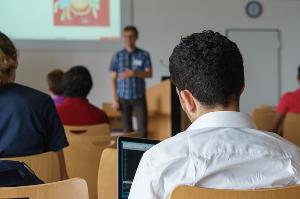
Séminaire
2025
séminaire jeudi 6 novembre 2025, 11h00 en salle 101 à l'UFR
Laura Fabris
Tuning the Electric Field at Plasmonic Hot Spots through Morphology Modulation and Interface Engineering
Plasmonic nanomaterials can be employed in a wide range of applications, including, among others, sensors, diagnostic platforms, and optical devices. One of the most important properties of these nanomaterials is their ability to generate hot spots upon interaction with impinging radiation. At these locations the scattered electric field reaches its highest levels and energetic hot electrons can be generated and extracted. The enhancement of the scattered electric field is a fundamental process at the basis, for instance, of surface enhanced Raman scattering and surface enhanced fluorescence effects, while the generated hot electrons are implied in several technologies, among which photocatalysis. To fully benefit from these phenomena, however, it is fundamental to establish and realize very specific materials design rules, which hinge, in particular, on morphology modulation and interface engineering. In my talk I will discuss how we have approached hot spot optimization by devising novel colloidal methods for the synthesis of plasmonic nanostructures and by studying in detail the interfacial properties of these nanostructures in various environments. I will report on how we have holistically integrated computational and experimental approaches to understand the properties of the systems under exam and will present a few case studies in which fundamental discoveries have led to real applicability.
séminaire jeudi 5 juin 2025, 11h00 en salle 101 à l'UFR
Jamie Noël
Evidence Supporting > 1 Million Year Corrosion Lifetimes Obtained Over a Much Shorter Period
This talk will discuss how we can reasonable justify claims that buried nuclear fuel waste disposal containers will survive more than one million years
séminaire lundi 20 janvier 2025, 14h00 en salle 101 à l'UFR
Patricia Horcajada
Advanced Porous Materials Unit, IMDEA Energy Institute. Móstoles-Madrid, Spain
Energy, environmental and health applications of MOFs at the Advanced Porous Materials Unit
The main objective of the Advanced Porous Materials Unit at IMDEA Energy Institute is to develop innovative multifunctional materials, with a full understanding of their structural features for improving the materials properties targeting specific relevant applications (i.e. energy, environment and health), and including the scale-up and fabrication of adapted devices.
In this context, a selection of some significant and recent results will be shown. For instance, some examples in the field of energy include the synthesis of new metal organic frameworks (MOFs) and their composites based on phosphonate ligands and different cations, exhibiting porous and robust structures with excellent proton conductivity (10-2-10-1 S/cm) and being promising materials as efficient proton exchange membrane in fuel cells. Also, several novel MOF structures have been prepared and fully characterized using electro/photoactive ligands and cations (e.g. Ti, Zr, Hf) with outstanding stability and optical properties. Without further modification and in absence of any co-catalyst or sacrificial agent, they are able to produce H2 and O2 from water at rates among the highest ever reported under visible light.
Concerning environmental applications, novel adsorbent and/or (photo)catalytically active materials (MOFs, carbons, composites) have been synthesized for both water remediation and fresh water treatment. In a further step, agrochemicals based MOFs have been originally prepared to progressively release a cocktail of biologically active ingredients (e.g. antibiotics, antifungals, pesticides, micronutrients) to crops, improving their efficiency and avoiding toxic side effect.
Finally, regarding the health-related applications, innovative formulations based on MOFs and challenging pharmaceutical active ingredients (e.g. drugs, proteins, nucleic acids, cosmetics) have been prepared, proving their safety and efficiency upon their administration by different routes (i.e. intravenous, oral, pulmonary, cutaneous).
séminaire jeudi 9 janvier 2025, 11h00 en salle 101 à l'UFR
Pascal Fongarland, Laboratoire Catalyse, Polymérisation et Matériaux (CP2M) à Lyon
"Procédés catalytiques de conversion de bio-ressources: transposition de batch en réacteur continu et apport du couplage réaction-séparation (séparation membranaire, distillation réactive ...)"
Si de nombreuses voies alternatives pour produire des molécules d'intérêts en convertissant des bioressources ont été proposées et étudiées, la problématique de la transposition à plus grande échelle de ces approches reste complexe en raison du grand nombre de phénomènes couplés et de paramètres qui peuvent influencer la productivité et leur faisabilité. La conversion des bioressources comme la biomasse lignocellulosique présente un grand nombre de défis dont la difficulté de caractériser finement les matrices initiales de manière quantitative, d'orienter de manière très sélective les réactions vers des produits d'intérêts malgré l'utilisation de catalyseurs de plus en plus sophistiqués, de pouvoir séparer les produits de manière la plus économique possible, et enfin de la problématique du changement d'échelle depuis la paillasse jusqu'au procédé à plus large échelle. Nous avons ainsi étudié la problématique de la transposition depuis le réacteur batch classiquement utilisé pour étudier la réactivité en réacteur triphasique type trickle-bed continu pour la conversion hydrothermale de lignine Kraft par oxydation catalytique en essayant de découpler les phénomènes entre réactions homogènes et catalytiques à travers la cinétique, et du couplage entre réaction et diffusion. Un exemple d'une autre stratégie en transposition en continu sur la valorisation des hémicelluloses sera présentée en utilisant l’approche par compartimentation et de réaction-séparation à l'aide d'une membrane afin de minimiser la production d'humines, produits de dégradation. Enfin, des exemples de développement de distillation réactive seront montrés notamment pour la récupération d'acides présents dans la liqueur noire du procédé Kraft ou pour obtenir une conversion totale lors d'une transestérification énantio-sélective avec une réaction enzymatique avec des internes structurés fonctionnalisés.
2024
séminaire vendredi 29 novembre 2024, 10h Amphithéâtre Durand
Fabio Ribeiro Professor Purdue University USA
Heterogeneous Catalysis: Enabling the Breakthroughs for a Sustainable Energy Transition
séminaire jeudi 12 juillet 2024
Eleni A. Kyriakidou Associate Professor University at Buffalo
High Silica Small Pore Zeolites for Low Temperature CH4 Oxidation Applications
séminaire jeudi 2 mai 2024
Adrien COUET Professor University of Wisconsin Madison
Molten Salt Corrosion Kinetics Prediction and Mechanism Interpretation Enabled by Integrated High-Throughput Experimental and Modeling Tools
séminaire jeudi 25 avril 2024
Benjamin Carbonnier Professeur des Universités ICMPE
Porous polymeric materials with controlled pore structure and surface functionality: Design and application
séminaire mardi 26 mars 2024
Joshua Owen Maître de conférences University of Leeds
Corrosion challenges in the transition to sustainable energy
séminaire mercredi 24 janvier 2024
Bonjun Ku Doctorant Université de Chungnam Corée
Catalytic study of dryreforming of methanereaction and water gasshift reaction
Siranuysh Badalyan Doctorant Université de Chungnam Corée
Solid Fe(II) catalystsfor electrochemicalNORR application
2023
séminaire lundi 27 mars 2023
Jaysen Nelayah maître de conférence à l'université de Paris-Cité
Nanoalliages multi-composants à haute entropie : synthèse, propriétés structurales et potentialités pour la catalyse hétérogène
séminaire jeudi 16 février 2023
George Z. Kyzas Professeur International Hellenic University
Graphene materials in wastewater treatment
séminaire lundi 13 février 2023
Sandra Casale et Ferdaous Ben Romdhane ingénieure d'étude et ingénieure de recherche
Principe et applications de la microscopie électronique en transmission pour l'étude des nanomatériaux
séminaire lundi 6 février 2023
Roger Guérin délégué à l'intégrité scientifique Sorbonne université
L'intégrité scientifique face à la faked science : des généralités au fonctionnement à Sorbonne Université
séminaire lundi 23 janvier 2023
Marjorie Olivier Professeure Université de Mons
Hydrotalcite modified coatings for corrosion protection of steel and Zn sacrificial layers
séminaire lundi 23 janvier 2023
Rodolfo Zanella Universidad Nacional Autónoma de Mexico et directeur du Centre d’études mexicaines
Catalyseurs mono et bimétalliques pour la photolyse de l’eau
séminaire mercredi 18 Janvier 2023
Dr Frédéric Meunier Directeur de Recherche au CNRS,IRCELYON UMR5256,
Quantitative operando IR studies involving CO and CO2: matching surface species with reaction products
2020
- Mardi 3 mars
Dr MORI Kohsuke (Associate Professor, Osaka University, Japon) :
"Nanocatalyst Engineering for Hydrogen Storage and Delivery Based on Formic Acid"
Dr KUWAHARA Yasutaka (Associate Professor, Osaka University, Japon) :
"Design of Hollow Nanostructured Catalysts Encapsulating Metal Nanoparticles and Aminopolymers for Hydrogenation Reactions"
- Lundi 9 mars
Jean-Michel NEGRONI (Géologue, société IMERYS)
"Présentation des activités industrielles du groupe IMERYS, leader mondial de spécialités minérales pour l’industrie"
- Lundi 16 mars
Dr Hervé TOULHOAT (Cherch. Bénévole LRS, ex-Dir. Adjoint IFP Energies Nouvelles) :
"Morphologie d’équilibre et spéciation de surface de nanoparticules: du calcul DFT à la caractérisation expérimentale"
- Lundi 23 mars
Dr Antonio AGUILAR-TAPIA (CNRS, Institut NEEL, Grenoble)
"Reaction cells for operando XAS characterization of catalysts"
2019
Lundi 21 janvier 2019
Vincent PELLAS
Biocapteur plasmonique à base de nanoparticules coeur-coquille Au@SiO2
Directrices de thèse :
- Souhir Boujday
- Michèle Salmain, IPCM
Avec la participation de Juliette Blanchard
Ilhem JAABAR
Étude de l'évolution os/cartilage au cours de l'arthrose par microscopie à force atomique
Directeurs de thèse :
- Jessem Landoulsi
- Houard, Polytech Sorbonne
Lise BEDOIN
Émergence de biopolymères de complexité contrôlée dans les scénarios d’Origine de la Vie
- Jean-François Lambert

Lundi 28 janvier 2019
1/Yacine MAZOUZI
Compréhension de l'interface organique/inorganique lors de l'assemblage de molécules fonctionnelles sur des surfaces planes pour des applications biologiques
Directrice de thèse :
- Souhir Boujday
Co-Encadrement : Juliette Blanchard, Vincent Humblot & Yannick Millot
2/Mathieu BALAS
Formation de carbonates cycliques à partir d'alcènes et de CO2 par voie catalytique "one-pot" en présence d'oxydants propres
Directeur de thèse :
- Franck Launay
3/François PAYAN
Elaboration par voie plasma hors équilibre de nouveaux matériaux oxydes à base de magnésium : propriétés basiques et réactivité catalytique en transestérification
Directrice de thèse :
- Hélène Pernot
Directeur de thèse :
- J-F. Hochepied
lundi 11 février 2019
Catalyse hybride pour activer le CO2 par combinaison de complexes moléculaires de Fer ou de Cobalt et de matériaux carbonés.
Marc Robert
Laboratoire Electrochimie Moléculaire - UMR CNRS 7591, Université Paris Diderot, Sorbonne Paris Cité
Lundi 4 mars 2019
Reaction mechanisms on inorganic surfaces : from isolated metal atom on surfaces for unusual N2 splitting and catalytic biomass conversion to growth of atomically thin layers of 2D materials.
Alessandra Quadrelli est chargée de recherche au CNRS au C2P2 Chemistry, Catalysis, Polymers and Processes (UMR 5265)

Jeudi 4 avril 2019
Using neutron spectroscopy to assess heterogeneous catalysts
Ahmed Naitabdi
Sorbonne Université, Laboratoire de Chimie Physique Matière et Rayonnement
"In situ investigation of chemical reactions on metal-oxide model nanocatalysts by near-ambient pressure XPS"
Vendredi 24 mai 2019
Professor S. Ted Oyama
University of Tokyo
Department of chemical system engineering
“Kinetic/spectroscopic technique (Analysis of Coverage Transients - ACT) to study model HDN and HDS reactions.”
Vendredi 14 juin 2019
John Regalbuto is Professor of Chemical Engineering and CeEE Endowed Chair in Renewable Fuels in the College of Engineering and Computing at the University of South Carolina.
Lundi 14 octobre 2019
Dr. Shuyun CHNG
«Nanomaterial synthesis, coating formulation and coating process development for applications such as anti-microbial, smart windows, anti-scratch»
